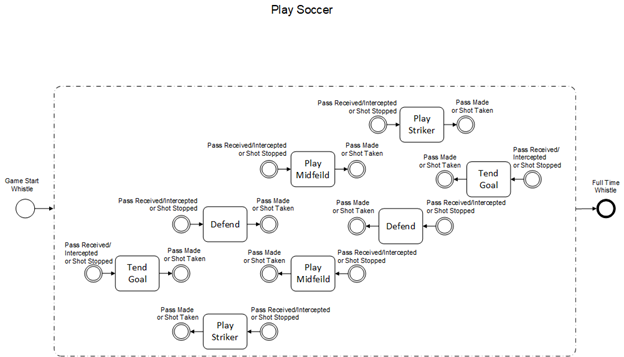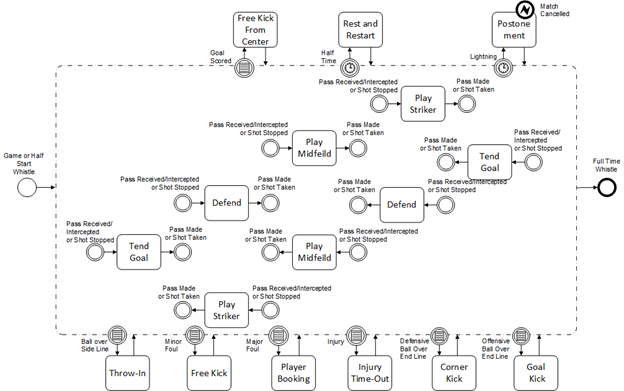
The Beautiful Game as a Modern, Event-Driven Business Process Structure
The Beautiful Game
Whether you call it football or soccer, “the Beautiful Game” as it is widely known, has simple rules of play. But playing soccer is another matter. It is a highly dynamic, agile process. In the flow of a single match, an eleven-player professional team can make more than 500 passes and there can be dozens of game stoppages.
In the eyes of process analysts, quality improvement professionals, and business analysts, who still rely on the more than 100 years-old, strictly procedural notions of a process and on flowcharting notations that were also invented in the last century, IT IS IMPOSSIBLE to perceive and model something like playing soccer as a sequential process.
The Modern Business Process Modeling Solution
The most effective business processes are not only structurally sound and efficient but also highly dynamic and agile. A high-quality business process structure today is one that has been conceived, structured, and can be readily configured as a network of specialized, collaborating, event-driven, and outcome-oriented services, not just as a sequential procedure.
If a business analyst, process analyst, quality analyst, or manager adopts that modern business process paradigm and a modeling notation that is aligned with how today’s business relationships and processes work, then perceiving and modeling something as dynamic and agile as the beautiful game as a process, IS NOT ONLY POSSIBLE, BUT ELEGANT.
Universal Business Process Definition[1]
The Universal Business Process Definition is not constrained to a strictly procedural notion of a process. It is an event and outcome-oriented business process paradigm. The Universal Business Process Definition’s four common-sense rules define all processes, workflows, and activities, regardless of a process’s scale, the overarching project methodology, the model’s required degree of abstraction, the modeling participants, and the organizations and the technologies that will implement the process or workflow.
The Universal Business Process Definition, and the Business Process Normalization technique are defined in the Universal Process Modeling Procedure (UPMP), published by ProcessModelingAdvisor.com.
Business Process Modeling and Notation[2]
Business Process Modeling and Notation (BPMN) is a graphical notation for illustrating modern business process elements. It overcomes the limitations of the last century’s procedural flowcharting and process mapping notations.
BPMN was defined by the Business Process Modeling Initiative (BPMI) and is maintained by the Object Modeling Group (OMG). BPMI states that the goal of BPMN is:
“To provide a notation that is readily understandable by all business users.”
BPMN is the best-suited notation for illustrating modern business process and workflow structures. It includes sequential flowcharting elements, but BPMN also includes symbols for illustrating concepts that are relevant to today’s dynamically collaborating systems and business processes. Namely, events and messaging.
Advertisement
The Beautiful Game as an Example
We don’t need process models about playing soccer. We’d rather be playing or spectating. But we’ve all observed enough about playing soccer to use it as a commonly understood example. Playing soccer happens to be similar to how modern-day business processes and operating relationships work. Let’s use soccer to demonstrate how to apply a modern business process modeling paradigm and modeling notation to discover and illustrate a sound, modern business process structure.
Event-Driven Business Process Flow
A contextually and structurally sound model of the Play Soccer process can be discovered by answering the Universal Basic Business Process Flow Elicitation Agenda[3] and the Universal Event and Outcome-Oriented Business Process Flow Elicitation Agenda[4], found in The Universal Process Modeling Procedure.
This basic, event and outcome-oriented (non-procedural) BPMN process flow diagram communicates the normal, dynamic flow of Play Soccer as a set of collaborating, specialized activities.

The Play Soccer process is initiated by a kick-off at center field. It is comprised of 4 activities: Tend Goal, Defend, Play Midfield, Play Striker. Activities are performed by the players of two teams. The expected outcome of Play Soccer is that a match has been played to its allotted time limit, according to its rules.
A free kick from center starts a match. Once the match starts all players in their assigned positions maneuver freely, whether they possess the ball or not. The expected succession of the keeper’s, defenders’, midfielders’, and strikers’ activities is determined dynamically, by the players, while the match is played, by receiving or intercepting passes, stopping shots, and by making passes or taking shots.
The player with the ball will pass the ball to any one of up to 10 other teammates or take a shot; Either the intended teammate will receive a pass, or an opposing player will intercept a pass or stop a shot, to possess the ball. Any player that possessed the ball will then maneuver (according to their assigned position level and their own skill) and then pass the ball to any one of up to 10 other teammates or take a shot. This succession of activities continues, until a stoppage in play.
The success of the expected outcome (pass made or shot taken) of one Play Soccer activity will determine the initiating event (pass received/intercepted or shot stopped) of another Play Soccer activity. The actual flow of a game is determined dynamically, by the players who are assigned to perform Play Soccer’s activities.
This basic, event and outcome-oriented process view of Play Soccer is contextually and structurally sound, but still basic. It is upon this solid, defining structure that one can elicit, add and communicate logical details that are relevant to how the Play Soccer process will “flow” and, that this model’s readers likely expect to see. What about conditional activities, like throw-ins, corner kicks, penalty kicks, substitutions, fouls, out-of-bounds, injuries), and delays (like injury time-outs, and half-time)?
Logically Refined Business Process Flow
The logical details about the periodic conditions, activities, and delays in the execution of the Play Soccer process can be straightforwardly discovered by asking and answering simple agendas that are defined in The Universal Process Modeling Procedure[5]. This refined BPMN process flow diagram communicates the conditional activities and delays that are expected to periodically occur throughout the dynamic flow of Play Soccer.

The BPMN process diagram shows that game events, not a sequential procedure determine what and when certain activities are performed in the Play Soccer process.
Even with all those refinements made, the contextually accurate and sound basic structure of the Play Soccer process, that we previously established, has not changed. These refinements can be graphically included or excluded, without any rework of the basic contextual meaning or basic diagrammatic structure of Play Soccer.
Activity dependencies are contextually accurate, without depicting a sequential procedure and sequential flows. Dynamic, alternate activities, paths, and timings throughout the process are accounted for in the model. Undue model complexity, and the analyst’s time that would have been spent on it, has been avoided. Process navigation decisions, and alternate flow paths are in fact modelled, but need not be explicitly illustrated as sequence flows.
Conclusion
The Beautiful Game serves us as a beautiful example of a process that is a set of dynamically collaborating sets of specialized services. It is not a sequential procedure. Modern business processes are not just sequential procedures either.
The Universal Process Modeling Procedure, with its Universal Business Process Definition and elicitation agendas, provides a modern process modeling paradigm, capable of event-driven as well as sequential business process elicitation and modeling. BPMN is a modern process modeling notation, that includes the graphical elements to represent business event-driven, not just sequential process flows.
With these tools in-hand, process analysts, quality improvement professionals, and business analysts, are capable of eliciting, perceiving, normalizing, defining and graphically illustrating structurally sound, modern business process structures.
Copyright 2022, Edmund Metera